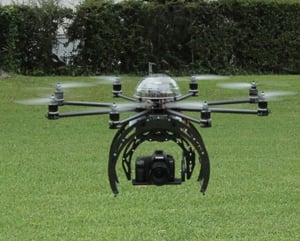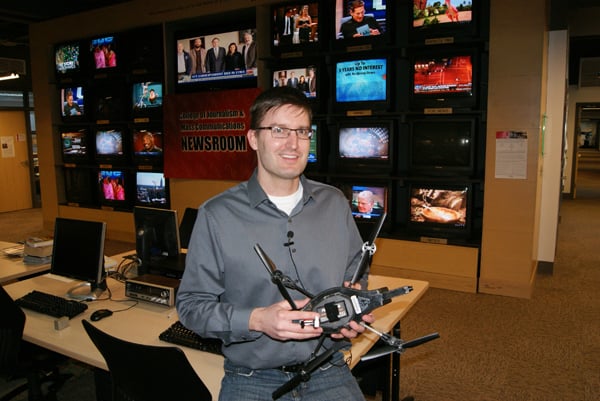
I don't know anything about you, but I bet I can place your reaction to what I'm about to say between two poles. On the one side is "This is the coolest thing I've ever heard of." On the other it's "Stop the world. I want off."
Ready?
Flying robots with cameras. For journalists.
If you're at all into technology, your first reaction is probably something like "Ooooh, that sounds awesome." But if you're a skeptic at all, once that cool vibe passes, a whole lot of questions start bubbling up.
OK, now what if I stopped calling them flying robots and started calling them drones?
That's right. Drones. For journalists. Drone journalism.
The technology you've been reading about in far away war zones is coming to the sky near you. And soon. There's a herd of industries interested in using unmanned aerial vehicles, or UAVs, to do things too expensive or too difficult to do now with manned aircraft. The cops aren't the only ones who want them. Oil and gas pipeline owners can monitor their assets with UAVs. Farmers can monitor their crops with them. Even golf course owners can learn which fairways need watering and which don't, saving thousands of gallons of water.
There are as many industries that could use UAVs as there are questions about safety, legality, and privacy involved in their use.
And I think there's a future in using drones for journalism.
Here's just one way.
Release the drones!
In the first days after a major disaster, the hardest questions for anyone to answer are how big, how far, how many, how much. Imagine, then, that you are a journalist sent to a city just devastated by some calamity. You barely know the city, there's little information about the scope and scale of the disaster, and you must now answer these questions for your readers or viewers, the sooner the better.
Put another way, imagine you are a reporter standing on a destroyed street. Rubble to the left, rubble to the right. How do you know if this block is the worst off? Or could the next one be? Or what about the next neighborhood over? Oh, and by the way, you're on deadline. You need to find the story, and fast.
I've been in this position many times as a reporter. I would say your only option is to dig in, start talking to people and do your best. But lately I've been thinking, what if there was a better way? What if technology had given us a tool that could help answer those hard questions quickly and cheaply?
The technology behind UAVs has advanced to the point where a hobbyist at their kitchen table can build an aircraft capable of autonomous flight. This was something that was only the domain of the military just a matter of years ago. Now, your local hobby store probably has the gear to do this. You can buy a quad copter that you can control with your smartphone that will beam back video to you wirelessly for $300 at just about any shopping mall. Autonomous flight is but a few parts and a little hacking away.
To be clear, these homegrown drones are a long, long way from the military UAVs your hear about in the news, but they can do a whole lot of useful things.
-- Lift a camera into the air. Sounds simple, but even a few hundred feet would give a journalist some considerable perspective on an event of large scale. A simple image from several hundred feet in the air could help journalists determine how many people were at a protest, or how far a tornado stayed on the ground, or how far the floodwaters extend.
-- Carry a GPS on board. Not for navigation, though that's dang handy, but for mapping. Maps are a universal language we all speak. Putting events on a map gives people a sense of scale and place. Journalists have used handheld GPS devices to map things, but what if you can't get there and there is no map of this thing?
-- Carry a host of other sensors. If you were a reporter in Japan in the wake of the Fukushima nuclear disaster, the area around the plant was not a neighborhood you wanted to be hanging out in. But you desperately wanted to know what the radiation levels were there. What if a drone could carry radiation sensors? Or place sensors that could wirelessly transmit data back?
Drones for journalism dawned on me a year ago, at a mapping conference in San Diego. In the cavernous vendor showcase at the ESRI International Users Conference, I found a Belgian company called Gatewing, selling a product called the X100. It looks like a small remote controlled airplane, but it's a fully-autonomous aerial mapping platform. You take it out, tell it where to take off from, where you want photographed from the air and where you want it to land. And off it goes. No pilot required. I handed the salesman on the floor my wallet and said let me take one home. He politely gave it back, said they were $65,000 and illegal in the U.S.
But I couldn't shake the idea. So I started looking into it, and found out that the FAA was considering new rules for UAVs in the public airways, and that in a few years I might be able to fly drones for news. So I went to my boss, the dean of the College of Journalism and Mass Communications at the University of Nebraska-Lincoln, and told him I wanted to start a Drone Journalism Lab.
Drone School
What are we going to do in a drone lab at a journalism school? Two things: First, figure out how you could cover news with a drone. What will it take? How will it work? What will you need? What do you need to think about before you fly? Second, professional journalism, when done right, operates by a given set of ethics. What new ethical guidelines are needed when using drones? What changes? What's a good use? What's going to get you sued?

How's it going? Well, we've just been awarded a $50,000 grant from the John S. and James L. Knight Foundation to really explore this idea. I'm working on assembling lab benches and getting a workspace set up now. And in the fall, I've got three undergrads ready to work. We've been flying a little proof-of-concept around, but now it's time to ramp up.
What could go wrong? Lots. Journalists do not have a lot of experience factoring in gravity into their storytelling. Crashing is a very real threat. People could get hurt.
What else can go wrong? People could flat misuse them. We're going to come up with ethical guidelines in the lab, but that doesn't mean anyone has to use them. Journalists could misuse drones -- spy in a window, invade privacy, stalk celebrities. That could provoke a lot of bad responses, from overreaching government regulation to lawsuits. What I hope will happen is that consumers of news will punish the bad actors. Nothing changes how a news organization acts like users fleeing in mass.
In spite of the risks, I think there's a real future for journalists using UAVs. As newsrooms shrink and budgets disappear, inexpensive tools that can gather unique and compelling data for storytelling become even more valuable. In the lab, we're going to find out if drones can be just that kind of tool. ![]()
Read more: Science + Tech














Tyee Commenting Guidelines
Comments that violate guidelines risk being deleted, and violations may result in a temporary or permanent user ban. Maintain the spirit of good conversation to stay in the discussion.
*Please note The Tyee is not a forum for spreading misinformation about COVID-19, denying its existence or minimizing its risk to public health.
Do:
Do not: